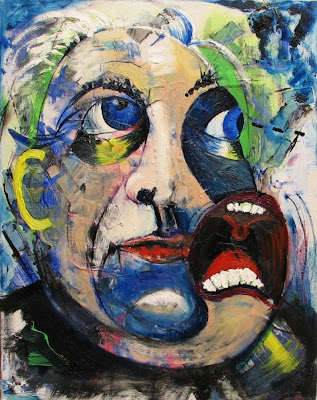by PHILIP JAEKL
 Inner Voices, oil & collage on canvas IMAGE/Harry Kent/Tachisme
Inner Voices, oil & collage on canvas IMAGE/Harry Kent/Tachisme
From a very early age, children learn to talk to themselves. That voice in your head is the thing that makes you, you
‘I think, therefore I am,’ the 17th-century philosopher René Descartes proclaimed as a first truth. That truth was rediscovered in 1887 by Helen Keller, a deaf and blind girl, then seven years of age: ‘I did not know that I am. I lived in a world that was a no world … When I learned the meaning of “I” and “me” and found that I was something,’ she later explained, ‘I began to think. Then consciousness first existed for me.’ As both these pioneers knew, a fundamental part of conscious experience is ‘inner speech’ – the experience of verbal thought, expressed in one’s ‘inner voice’. Your inner voice is you.
That voice isn’t the sound of anything. It’s not even physical – we can’t observe it or measure it in any direct way. If it’s not physical, then we can arguably only attempt to study it by contemplation or introspection; students of the inner voice are ‘thinking about thinking’, an act that feels vague. William James, the 19th-century philosopher who is often touted as the originator of American psychology, compared the act to ‘trying to turn up the gas quickly enough to see how the darkness looks’.
Yet through new methods of experimentation in the last few decades, the nature of inner speech is finally being revealed. In one set of studies, scans are allowing researchers to study the brain regions linked with inner speech. In other studies, researchers are investigating links between internal and external speech – that which we say aloud.
The roots of the new work trace back to the 1920s and the Russian developmental psychologist Lev Vygotsky, who said the human mind was shaped by social activity and culture, beginning in childhood. The self, he hypothesised, was forged in what he called the ‘zone of proximal development’, the cognitive territory just beyond reach and impossible to tackle without some help. Children build learning partnerships with adults to master a skill in the zone, said Vygotsky, then go off on their own, speaking aloud to replace the voice of the adult, now gone from the scene. As mastery increases, this ‘self-talk’ becomes internalised and then increasingly muted until it is mostly silent – still part of the ongoing dialogue with oneself, but more intimate and no longer pronounced to the world. This voice – at first uttered aloud but finally only internal – was, from Vygotsky’s perspective, the engine of development and consciousness itself.
Vygotsky’s theory of childhood development contrasted sharply with those of his Western counterparts. William James had a complete disdain for the study of inner speech, because, to him, it was a ghost: impossible to observe. The French developmental psychologist Jean Piaget insisted that private speech signified simple inability – it was the babble of a child without capacity for social communication with no relation to cognitive functioning at all. Through much of the 20th century, Piaget seized the reigns of child development, insisting that children had to reach a developmental stage before learning could occur. Which came first: the chicken or the egg? Vygotsky said that learning occurred, then the brain developed. Piaget said the brain developed, then learning occurred.
Aeon for more
